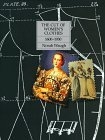-
History of:
- Resources about:
- More:
- Baby walkers
- Bakehouses
- Bed warmers
- Beer, ale mullers
- Besoms, broom-making
- Box, cabinet, and press beds
- Butter crocks, coolers
- Candle snuffers, tallow
- Clothes horses, airers
- Cooking on a peat fire
- Drying grounds
- Enamel cookware
- Fireplaces
- Irons for frills & ruffles
- Knitting sheaths, belts
- Laundry starch
- Log cabin beds
- Lye and chamber-lye
- Mangles
- Marseilles quilts
- Medieval beds
- Rag rugs
- Rushlights, dips & nips
- Straw mattresses
- Sugar cutters - nips & tongs
- Tablecloths
- Tinderboxes
- Washing bats and beetles
- Washing dollies
- List of all articles
Subscribe to RSS feed or get email updates.
The young mistress, the next week, tumbled into the wash an amount of muslin and lace and French puffing and fluting sufficient to employ two artists for two or three days, and by which honest Bridget, as she stood at her family wash-tub, was sorely perplexed.
Harriet Beecher Stowe, Pink and White Tyranny, 1871
The Cut of Women's Clothes: 1600-1930, from Amazon.com
Or from Amazon UK
Christie clapped laces, sprinkled muslins, and picked out edgings at the great table where Mrs. Wilkins stood ironing, fluting, and crimping till the kitchen bristled all over with immaculate frills and flounces.
Louisa May Alcott, Work: A Story Of Experience, 1872
Perfume for a lady's chamber; Golden quoifs and stomachers For my lads to give their dears; Pins and poking-sticks of steel; What maids lack from head to heel: Come buy of me, come; come buy, come buy, Buy, lads, or else your lasses cry:. Come buy!
Shakespeare, Winter's Tale, c1610
Ironing frills - from Elizabethan ruffs to Victorian ruffles
Fluting, goffering, Italian, crimping, poking irons
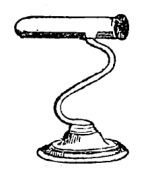 Anyone who's pressed clothes
with an iron on a flat surface knows it's easy to make a crease. So how can you
iron waves of ruffles and keep the flounces without flattening them? One solution
was a
goffering iron, also called an Italian or tally iron. This was like a metal
test tube set horizontally on a stand. (See right) The tube was heated by inserting
a metal poker-like rod, fresh from stove or hearth. Then frilled cuffs and collars
could be curled round the cylinder, and other trimmings, like ribbons, were moved
across it. Some Victorians took pride in a display of expertly-ironed ruffles, and
the well-dressed baby often had a bonnet trimmed with "Italian-ironed double frills",
as mentioned by Charlotte Brontë in 1849.
Anyone who's pressed clothes
with an iron on a flat surface knows it's easy to make a crease. So how can you
iron waves of ruffles and keep the flounces without flattening them? One solution
was a
goffering iron, also called an Italian or tally iron. This was like a metal
test tube set horizontally on a stand. (See right) The tube was heated by inserting
a metal poker-like rod, fresh from stove or hearth. Then frilled cuffs and collars
could be curled round the cylinder, and other trimmings, like ribbons, were moved
across it. Some Victorians took pride in a display of expertly-ironed ruffles, and
the well-dressed baby often had a bonnet trimmed with "Italian-ironed double frills",
as mentioned by Charlotte Brontë in 1849.
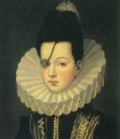 The inner rod of the goffering iron was no different
from the hot poking-stick or poking-iron used in the 16th and 17th centuries. This
was very like an ordinary fireplace poker and was used to help create the stiff
ruffs fashionable during the Renaissance, like the cartwheel ruff worn by the Spanish
Princess of Eboli to the left, or the ruffs associated with the English Queen Elizabeth.
These elaborate collars had originally been created with unheated setting sticks
that fixed pleats in damp, heavily-starched
ruffs while they dried - a bit like setting hair - until the heated poking-stick
came into use around 1570. The laundress-gofferer needed a stand to support ruffs
while she "styled" them with this object. Other names for the poking-iron were poting-stick
or putting-stick.
The inner rod of the goffering iron was no different
from the hot poking-stick or poking-iron used in the 16th and 17th centuries. This
was very like an ordinary fireplace poker and was used to help create the stiff
ruffs fashionable during the Renaissance, like the cartwheel ruff worn by the Spanish
Princess of Eboli to the left, or the ruffs associated with the English Queen Elizabeth.
These elaborate collars had originally been created with unheated setting sticks
that fixed pleats in damp, heavily-starched
ruffs while they dried - a bit like setting hair - until the heated poking-stick
came into use around 1570. The laundress-gofferer needed a stand to support ruffs
while she "styled" them with this object. Other names for the poking-iron were poting-stick
or putting-stick.
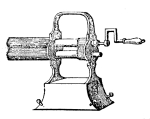 For rows of frilled trimming,
crimping or goffering (gauffering) tongs could be used. These were applied
to starched lace edging or ruffles, once they were arranged ready in a suitable
position. (More info on starching muslins and delicate
clothing.) In 1863 Isabella Beeton, the Victorian "household management"
expert, advised that the tongs should be "placed in a clear fire for a minute, then
withdrawn, wiped with a coarse rubber [polishing cloth], and the heat of them tried
on a piece of paper." Anyone who had seen irons like these in use knew how much
work was involved. (See left-hand column) By the mid-19th century crimping machines
- fluted rollers turned by a handle - were in use. (Picture right) Also called fluting irons, or fluters,
many slightly different models were designed for creating rows of narrow, neat
and
even frilling.
For rows of frilled trimming,
crimping or goffering (gauffering) tongs could be used. These were applied
to starched lace edging or ruffles, once they were arranged ready in a suitable
position. (More info on starching muslins and delicate
clothing.) In 1863 Isabella Beeton, the Victorian "household management"
expert, advised that the tongs should be "placed in a clear fire for a minute, then
withdrawn, wiped with a coarse rubber [polishing cloth], and the heat of them tried
on a piece of paper." Anyone who had seen irons like these in use knew how much
work was involved. (See left-hand column) By the mid-19th century crimping machines
- fluted rollers turned by a handle - were in use. (Picture right) Also called fluting irons, or fluters,
many slightly different models were designed for creating rows of narrow, neat
and
even frilling.
19th century inventors thought of more and more ways of tackling specialist ironing tasks. and a combined fluting and sad-iron was patented in the USA in 1870. As well as the two ridged rollers way of making frills, fluting could be done between hinged sections, which would swing shut to create a general-purpose iron for pressing the flatter parts of garments. (See picture bottom right.)
Puffing and egg irons
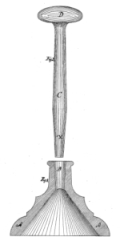 A puffing or puff
iron (left), or
egg-iron, provided a suitably curved surface for tackling awkward shapes
like puffed sleeves or gathered cuffs. It was a heated metal egg: sometimes standing
upright for cloth to be moved across and around it, or sometimes held by its handle
so you could press it into fiddly corners. In France people also used Kabyle irons
(North African style - see
'irons & smoothers' page) for intricate ironing tasks.
A puffing or puff
iron (left), or
egg-iron, provided a suitably curved surface for tackling awkward shapes
like puffed sleeves or gathered cuffs. It was a heated metal egg: sometimes standing
upright for cloth to be moved across and around it, or sometimes held by its handle
so you could press it into fiddly corners. In France people also used Kabyle irons
(North African style - see
'irons & smoothers' page) for intricate ironing tasks.
The puffing iron and stand illustrated were patented in 1871, as an "improvement in puffing irons" for "ironing puffs and ruffles in wearing apparel". The inventor, Martha Parry of New York state, said the ironing-head was to be heated upside down on a stove. It would then stand in its base while "ornamental parts of the garment which cannot be opened out" were smoothed around it.
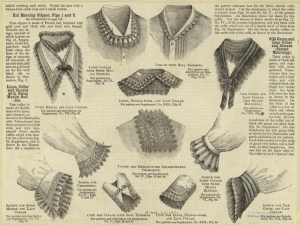 This
was a decade when ruffled trimmings were more in fashion than ever. (See 1870s US
fashion magazine right.) Many of these were probably tackled with a pair of crimping
tongs, or might even have been pressed flat by busy home launderers, but there was
by now a range of elaborate fluting gadgets for professional dressmakers and laundresses.
Some of these were complex machines; others were not too different from the ridged
wooden crimping boards and rollers
which had been in use since the late 17th/early 18th century.
This
was a decade when ruffled trimmings were more in fashion than ever. (See 1870s US
fashion magazine right.) Many of these were probably tackled with a pair of crimping
tongs, or might even have been pressed flat by busy home launderers, but there was
by now a range of elaborate fluting gadgets for professional dressmakers and laundresses.
Some of these were complex machines; others were not too different from the ridged
wooden crimping boards and rollers
which had been in use since the late 17th/early 18th century.
In any particular time and place, there may have been different names for different kinds of frills - crimping often suggests quite narrow grooves or tight gathering, for example - but generally there isn't any clear-cut way of distinguishing, say, fluting from goffering.
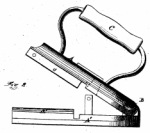 Other terms used to describe frills and fluting, and the irons used for them:
Other terms used to describe frills and fluting, and the irons used for them:
- ruches, ruching
- quilling
- pleating - often called plaiting in the past - here for example.
<< << Irons & smoothers >>>> Ironing boards
See also:
How muslins were starched before being ironed
History of starching
You may like our new sister site Home Things Past where you'll find articles about antiques, vintage kitchen stuff, crafts, and other things to do with home life in the past. There's space for comments and discussion too. Please do take a look and add your thoughts. (Comments don't appear instantly.)
For sources please refer to the books page, and/or the excerpts quoted on the pages of this website, and note that many links lead to museum sites. Feel free to ask if you're looking for a specific reference - feedback is always welcome anyway. Unfortunately, it's not possible to help you with queries about prices or valuation.


